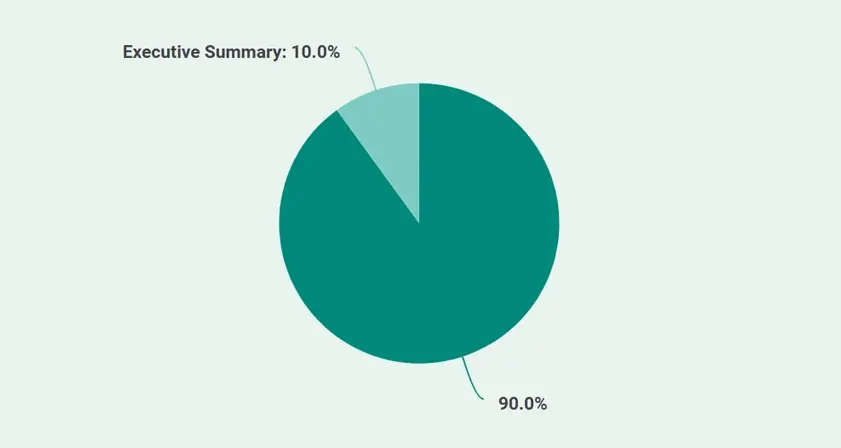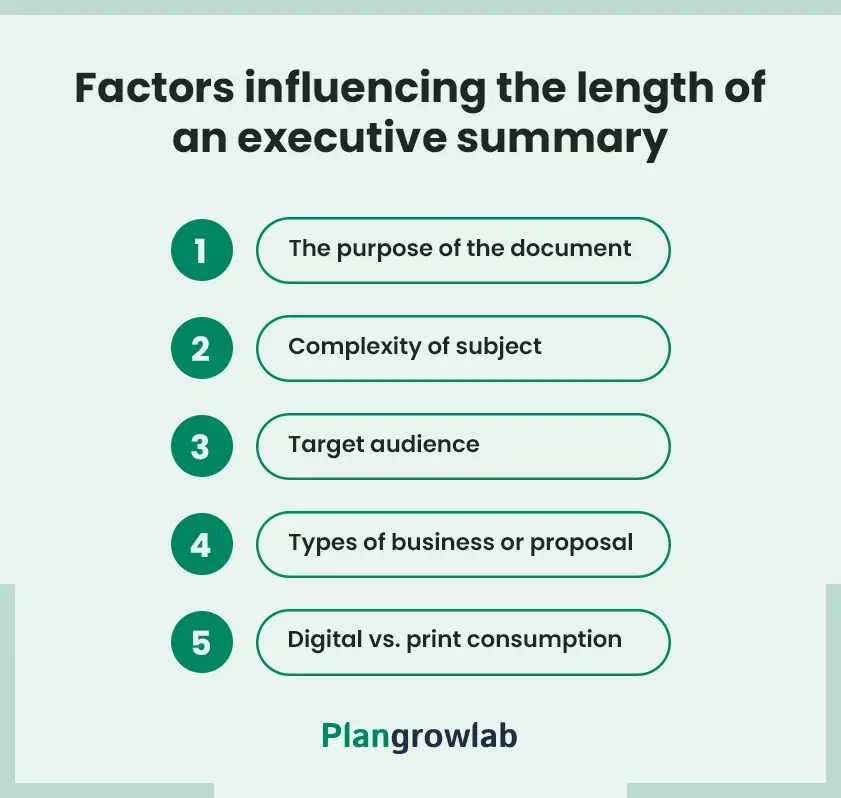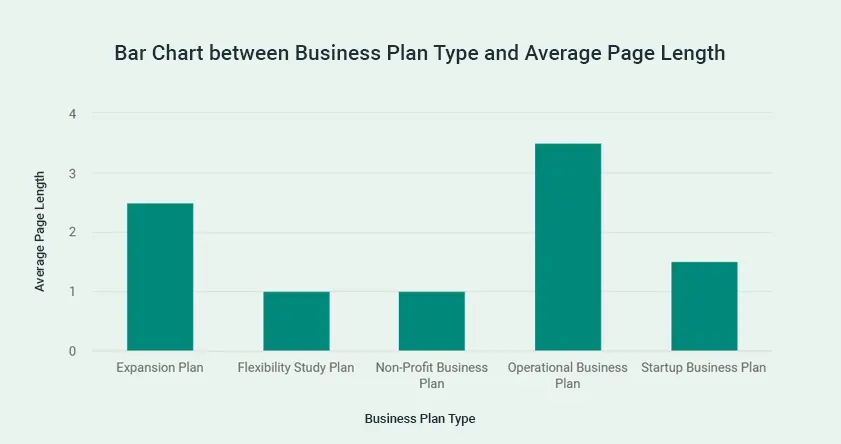If there’s one section we end up rewriting the most in business plans, it’s the executive summary.
Founders either try to cram everything into it, or they leave it vague and fluffy. Both miss the mark.
In our consulting work, I treat the executive summary like a pitch on paper. It’s not just an intro; it’s the deciding factor for whether someone keeps reading or tosses the deck aside.
Most investors won’t go beyond this page unless it provides them with a compelling reason to do so.
So when people ask me, “How long should an executive summary be?” I tell them: Long enough to cover what matters, short enough to keep their attention. Usually, that means 1-2 pages, but the real question is what you do with those pages.
In this article, I’ll walk you through how we approach executive summaries at PlanGrowLab.
How long should an executive summary be?
If your executive summary is for an executive, keep it 1-2 pages. For a lender, 2-3 pages is ideal, while for an investor, 1-3 pages should suffice. Overall, keeping your executive summary to 10% of your business plan is an ideal length for an executive summary.

This length strikes the right balance between providing essential information and maintaining the reader’s attention.
Here’s why 1-2 pages is the optimal length:
| Aspect | Why 1-2 Pages is Ideal | How to Add Value to Your Executive Summary |
|---|---|---|
| Attention Span | With attention spans dropping to 8 seconds, a brief summary keeps readers engaged long enough to grasp key points. | Start with a compelling hook that highlights a critical problem or solution. |
| Executive Preferences | 83% of executives prefer concise summaries that quickly communicate essential information. | Focus on outcomes and benefits rather than just details and data. |
| Clarity and Focus | A shorter length forces you to present information clearly, making it easy to understand. | Use bullet points and subheadings to improve readability. |
| Information Overload | Concise summaries help cut through the noise of overwhelming information executives receive daily. | Include a key takeaway section summarizing critical insights in one or two sentences. |
| Decision-Making Efficiency | A well-structured summary enables faster decision-making by highlighting essential points. | End with a clear call to action to guide the reader toward the next steps. |
| First Impressions | A succinct, engaging summary creates a strong first impression and encourages readers to explore further. | Use data or a powerful quote upfront to grab attention immediately. |
| Versatility | A 1-2 page length works across various reports, from business plans to proposals. | Tailor your summary to address your audience's specific needs or pain points. |
Factors influencing the length of an executive summary
Here are some key factors to consider that will help you determine the appropriate length:

1) The purpose of the document
| Purpose | Ideal Length | Reason |
|---|---|---|
| Funding Proposal | 1 page or less | To capture investors' attention quickly by highlighting key outcomes, financials, and ROI. |
| Business Report | 2-3 pages | To provide comprehensive context, background, and detailed findings for informational purposes. |
| Internal Operations Guide | 1-2 pages | To outline actionable steps and team-specific details without overwhelming staff with excessive data. |
The purpose of placing the table at the top is to demonstrate how the intended goal of the document can influence the length of the executive summary.
When I review client plans, one of the first questions I ask is: “Who’s reading this, and what do they want from it?” That single answer usually tells me everything about how long (or short) the summary should be. If the audience is short on time or attention, like investors, you’ve got one page to make your case.
If the goal is to drive quick decisions, such as in a funding proposal or business pitch, I recommend keeping it short and focused—ideally one page or less. This captures attention faster and highlights only the most critical points without unnecessary detail.
On the other hand, if the summary is for informational or educational purposes, like an in-depth business report, you can extend it to 2–3 pages to provide more context and background.
I’ve even advised clients to prepare two versions: A concise one-pager for pitching and a longer version to include in the full business plan for context. Different readers, different needs.
In the end, it’s up to you to decide how much detail to include and what’s essential for your audience. My rule is simple: If time is a factor, less is more. If they need a deeper understanding, guide them toward the appendix.
2) Complexity of subject
When your subject is complex, you might think, “I need more space to explain this.” And while that might feel true, adding too much detail can overwhelm your reader.
I’ve seen plans where the executive summary turned into a technical deep dive. The founders meant well, but we had to pull it apart and ask, “Would an investor make it past paragraph two?” Often, the answer was no.
And that’s where you lose your audience. Most readers—especially busy executives—don’t have the time or patience to sift through pages of technical details.
To overcome this, I always tell clients to ask themselves: “What are the three most important things my audience needs to know?” Stick to those. Even if your topic is complex, avoid jargon where you can. If technical terms are necessary, provide a quick, plain-language explanation.
One tip I share with clients: If your engineer loves it, but your operations head looks confused, you’ve gone too far.
Charts, graphs, or bullet points can convey complex information quickly and clearly without adding to the length. I recommend making smart use of these visuals so your audience gets the clarity they need in less time. In the end, brevity paired with clarity always wins.
3) Target audience
Your executive summary will be read by various audiences—executives, lenders, and investors—each with different needs.
Executives typically prefer a quick, concise overview focusing on key takeaways and strategic insights.
Lenders and investors, on the other hand, may need more detailed information about your business, such as financial projections, growth potential, and risk factors.
Sometimes one investor might flip to the financials immediately, while another might ask about the market size before reading a word. That’s why we tailor summaries per audience, not per template.
This is why the length and depth of your executive summary vary based on your audience. As a result, you’ll have to tailor your executive summary as well. Here’s how:
| Audience | Preferred Length | Content Focus |
|---|---|---|
| Executives | 1 page or less | Key outcomes, strategic recommendations, and high-level insights. |
| Lenders | 1-2 pages | Financial stability, repayment plans, and risk mitigation strategies. |
| Investors | 2-3 pages | Business model, growth potential, market opportunity, and return on investment. |
| Internal Team | 2-3 pages | Detailed operational plans, roles, timelines, and departmental goals. |
| External Team | 1-2 pages | Project scope, collaboration guidelines, deliverables, and key milestones. |
Oftentimes, while reviewing summaries with clients, we ask: “Would this version make sense to someone who only sees one part of the business?” If the answer is no, it’s back to rewriting.
4) Types of business or proposal
Different businesses and proposals demand varying levels of detail, directly influencing the length of your executive summary. The following chart illustrates how the length of an executive summary varies based on the business type:

When it comes to a new business startup, the executive summary should be brief, focusing primarily on the business's aim and purpose. There's no need for extensive explanation since the goal is to grab the attention of potential investors or stakeholders quickly.
In reviews, I’ve found that most early-stage founders either overshare (trying to validate the idea too much) or undershare (hoping the idea speaks for itself). Neither works. So always focus on clarity and why now.
In contrast, the executive summary for an existing business may require more detailed information. This includes adding past performance data and background context, which helps build a clearer picture of the business's history and current standing.
For established businesses, I recommend including a quick “then vs now” snapshot. Investors want to see progress, not just potential. One well-placed chart can do more than three paragraphs of text.
Hence, the business type directly influences the executive summary's length and content.
Tips for keeping your executive summary concise, regardless of the business type:
- Focus on key points: Highlight only the most critical information relevant to your audience.
- Avoid jargon: Use clear and simple language to convey your message effectively.
- Be specific: Provide concise details without unnecessary elaboration.
- Stick to the essentials: Emphasize outcomes, recommendations, and essential facts.
- Limit background information: Only include context that directly supports your main points.
5) Digital vs. print consumption
The way your audience consumes your document—digitally or in print—significantly affects the ideal executive summary length.
Digital formats allow for easy scrolling, making slightly longer summaries (up to 2-3 pages) manageable without losing reader engagement.
In our case, clients tend to write longer digital summaries but forget to structure them. That’s where they lose readers. For digital, layout matters as much as content—headings, bullets, short paragraphs, all help.
On the other hand, print documents are less user-friendly for longer summaries, as flipping through pages can feel tedious. This often necessitates a more concise format, ideally 1-2 pages.
When I prep print-ready business plans, I often test the summary in real-world print settings. If it feels like a drag to flip through, the reader will likely stop midway. Brevity wins in print.
Tailor your executive summary to the medium. For digital formats, structure the content with headings and bullet points to maintain engagement while accommodating slightly more detail.
For print formats, prioritize clarity and brevity, focusing only on essential information to ensure readability without excessive page turns. Always test the readability of your summary in its final format to ensure it aligns with audience expectations.
Wrapping up
It’s clear, the ideal length of an executive summary isn’t one-size-fits-all. Whether it’s a concise 1-pager or a detailed 3-pager, every word must contribute to a compelling narrative.
It all depends on the key factors that influence it.
However, writing an executive summary for a business plan can be a challenging task, requiring precision and expertise.
Plangrowlab provides professional business plan writers who specialize in creating customized executive summaries that perfectly align with your business objectives and resonate with your target audience.
Connect with our experts today to craft an executive summary that delivers real results.
Frequently Asked Questions
How long is a typical executive summary of a business plan?
A typical executive summary is 1-2 pages long, however, it depends upon the complexity of the plan, type of business, and audience.
Can an executive summary be just one paragraph?
Yes, for simple documents or pitches, a one-paragraph summary can suffice if it conveys the key points clearly.
Is there a maximum length for an executive summary?
While there’s no strict limit, it’s best to keep it under 2-3 pages to maintain clarity and reader engagement.
Does the executive summary length vary by industry?
Yes, industries with technical or detailed content may require longer summaries to explain key aspects clearly.


